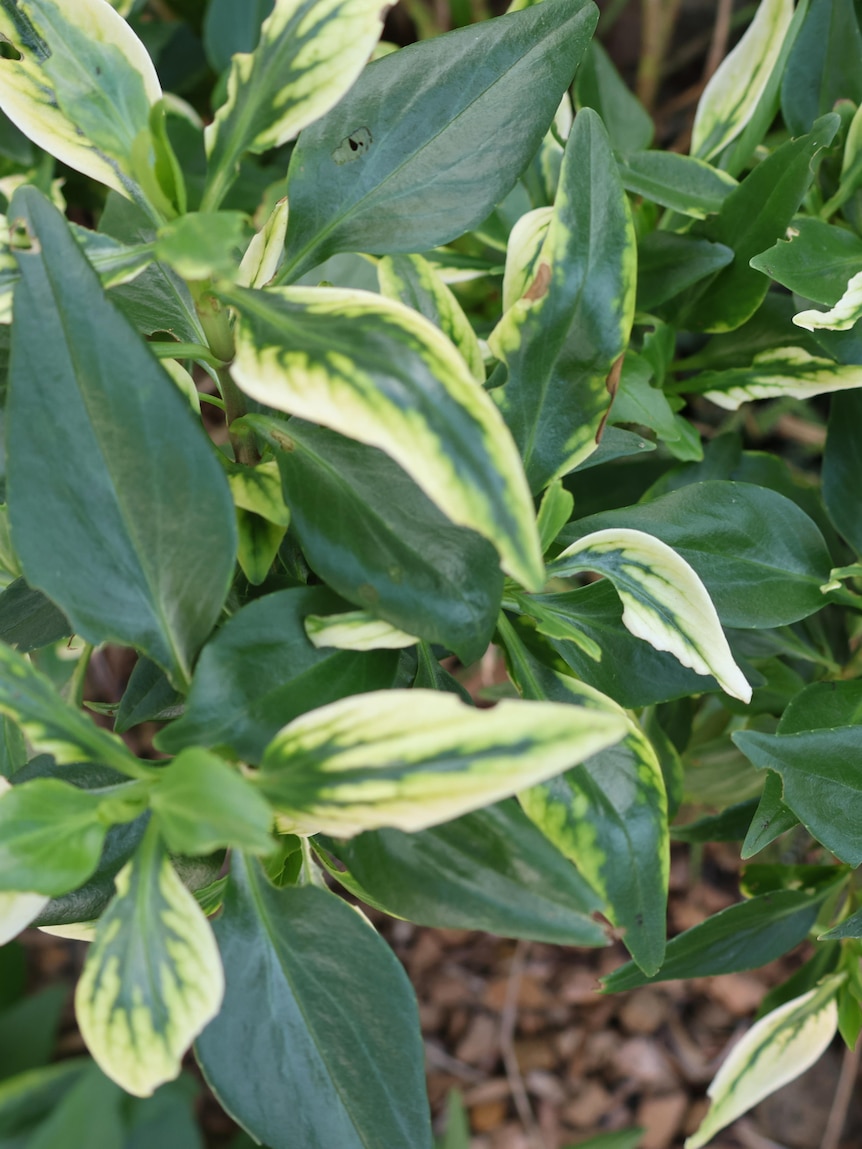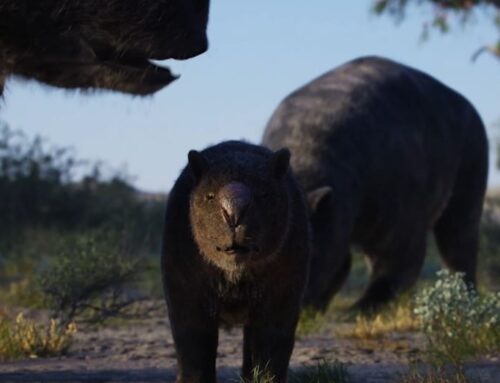John Peters was stumped when multiple plants in his expansive Yorke Peninsula garden started changing colour and his roses stopped flowering.
Key points:
- An investigation by the SA government into a pre-emergent herbicide has found no evidence of misconduct
- Regional communities are concerned the chemical will cause damage again next year
- The investigation team suspects some users did not get their application methodology right and will be conducting workshops
“Every plant, all the way around, every plant … had bleach,” he said.
“Every leaf had a yellow strip, all the way around the edge of it … every leaf, the whole garden.
“I didn’t know what it was until a bloke down the road came down here and said it was spray drift damage.”
The Alford gardener is among 26 landholders in South Australia’s Yorke Peninsula and Mid North to report bleaching of his plants, alleging it was spray drift damage caused by a new farm chemical called Overwatch.
Launched in 2021, the pre-emergent herbicide was developed by FMC and is known for its ability to control rye-grass — one of the country’s worst weeds in barley, wheat and canola crops.
In the same year it became commercially available, landholders in three different states had reported bleaching.
Complaints and a class action
In August 2021, an agronomist in Young, NSW, told The Weekly Times many of his clients had reported bleaching, but overall found the product so effective against weeds that only one out of the 10 said they would not use it again.
The next month, a Sydney law firm launched a class action on behalf of landholders in Victoria.
In late September, an FMC spokesperson confirmed to The Weekly Times the manufacturer had received 40 complaints of bleaching of wheat, barley, and canola crops mostly in South Australia.
The product manager attributed the bleaching to weather conditions in Victoria’s Western District, which had seen a dry start followed by persistent wet weather in June and July of 2021.
The spokesperson added that of the 1.2 million hectares of crop across Australia that was sprayed with Overwatch only about 1 per cent had been affected by bleaching.
The latest investigation into the farm chemical, which involved Mr Peters and 25 other SA landholders, was conducted by the state government’s Rural Chemical Operations Unit.
It subsequently found no evidence of application misuse but observed crop and plant symptoms that were “distinctive” of Overwatch bleaching and discolouration.
Awaiting answers
Six months on from when he first noticed the damage to his garden in the second week of May, Mr Peters said his plants had not recovered and he had not been told if they would.
“They haven’t given me any answers … Is my fruit safe to eat?” he said.
“Will they flower this season? If they didn’t flower this season, I can’t see them flowering the next one.”
Normally at this time of year, Mr Peters said his fruit trees would be full of fruit.
Instead, many of their leaves still showed signs of bleaching around their edges.
Many of the plants and flowers also held sentimental value.
“They’re my mother’s grandmother’s plants,” he said.
“You can’t put a price on them.”
With harvest coming to an end for another year, Mr Peters was concerned about what another season of potential spray drift would do to his garden.
“I don’t think they’ll survive next time round,” he said of his plants and flowers.
‘Distinctive’ symptoms
The Department of Primary Industries and Regions’ (PIRSA) investigation into the 26 reports of bleaching, which included Mr Peters’ garden, found that the majority of damage was observed in garden plants in neighbouring townships.
PIRSA’s manager for investigations and operations, Michael McManus, said the symptoms in plants were “distinctive” of Overwatch, presenting as “bleaching or purple” in appearance.
“These symptoms indicated that the chemicals had moved off target as the damaged gardens weren’t right next to the gardens affected,” he said.
“When a chemical is used by a producer, we want it to be staying on the target and targeting weeds.
“We certainly don’t want it drifting, so when we see symptoms occurring some distance away from where the chemical was used, we are concerned something’s gone wrong,” he said.
Mr McManus said the investigation was challenging as PIRSA did not speak to every producer who used the chemical in the region but, from the ones they did speak to, there was no evidence of misuse.
“The right droplet size, the right weather conditions [were observed], and certainly they [landholders] weren’t spraying in inversion conditions,” he said.
However, these findings led the investigation team to suspect that some users “weren’t quite getting their application methodology right”.
PIRSA will work with Grain Producers SA to improve awareness and training for chemical users early next year with workshops to ensure there is not a repeat during this year’s harvest.
“We’ve got quite strong legislation … what can happen is we could prosecute someone and there can be fines of over $30,000 if somebody is using a chemical incorrectly,” Mr McManus said.
Class action launched
The Sydney law firm that launched the class action against FMC following complaints said there were fears the bleaching would cause substantial yield penalties.
Brett Imlay, a special counsel with law firm Levitt Robinson, said farmers and agronomists had said the damage was the worst they had seen in their careers.
There have been no updates on this class action since, with FMC’s then-managing director, Kristina Hermanson, saying class actions can take up to three or four years.
Monitor conditions carefully
A grain producer and agronomist in South Australia’s south east, Nick Hillier, said Overwatch was an important chemical for broadacre grain farmers, but he had heard complaints about the herbicide.
“In my experience, if you stick to the label and monitor your spraying conditions and look for adverse aversions then you won’t have any issues, that I’m aware of,” he said.
“If you don’t know [or] understand what an adverse aversion is, you shouldn’t be a sprayer.
“It’s all to do with spraying, speed [and] time of day.”
A spokesperson from FMC told ABC North and West that, as far as the company was aware, the PIRSA investigation had not involved chemical residue analysis and was based on visual observation alone.
They added that symptoms which showed up on plants and crops could have been misdiagnosed as Overwatch, as “many factors such as soil properties, plant nutrition, environmental conditions and the use of other agricultural chemicals” could cause these symptoms.
“If applied incorrectly, all agricultural chemical products can move from the site of application as spray drift,” the FMC spokesperson said.
“If Overwatch Herbicide is involved in a spray drift incident, sensitive plants can show a colour effect that appears as a ‘bleaching’ of the plant. Typically this effect is temporary, and there is no impact to the plants.”
The spokesperson said its herbicide posed no threat to human health when applied correctly, adding that the APVMA and the Department of Health had both determined Overwatch’s toxicity profile was “very low”.
“If any small amount of spray drift were to contact drinking water collection areas or fruit and vegetables in gardens or nearby fields, the risk would be extremely low due to its extremely low toxicity to humans,” they said.
Over the past three seasons, FMC has been providing face-to-face stewardship training, webinars and other education material to growers, resellers and agronomists to reinforce correct application procedures.
“In early 2024, FMC will be running another series of spray application workshops across South Australia, and we encourage farmers to attend these in-person training sessions,” the spokesperson said.
Posted , updated





